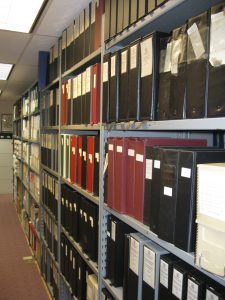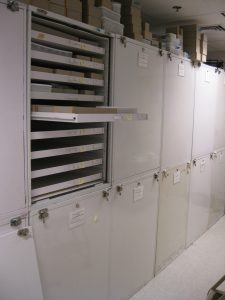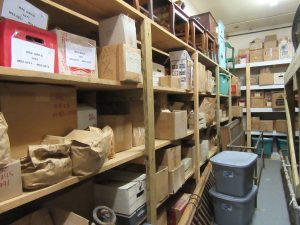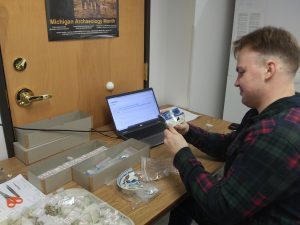Mackinac State Historic Parks has been conducting archaeological excavations at its sites for over sixty years. This has resulted in the recovery of over one million artifacts and reams of field notes, maps and other documentation of the excavations. Because excavating a site destroys it, preserving these artifacts and records is a crucial part of MSHP’s stewardship mission.


For many years the artifacts were housed in Lansing, while the records were stored in Mackinaw City. Paper records were microfilmed, with the microfilm stored in a separate location as a physical back-up copy. Today the paper records are scanned instead.
In the mid-1990s, MSHP purchased a computerized collections database package. We subsequently received a grant from the federal Institute of Museum and Library Services (IMLS) to enter all the archaeological artifact catalog information into the database. Three data entry clerks were hired for two years to accomplish this task. The biggest gap in the initial data entry project was that the artifacts were still in Lansing, so their exact storage locations could not be entered.


With the completion of the Petersen Center in 2001, the archaeological collections were moved north. The vast majority are housed in the Petersen Center, but building materials, such as chinking and nails, which have less strict climate control requirements, are stored at Dousman’s Mill. Once the collection was moved north, staff attempted to update the database with location information, but the task was too big to complete alongside other duties. In 2010 another IMLS grant was secured to hire three inventory assistants. Over the course of two years, they physically inventoried and updated the database record for all the Michilimackinac archaeological artifacts housed in the Petersen Center.


While the Michilimackinac collection makes up the majority of the archaeological collection, major excavations have been carried out at Fort Mackinac and Dousman’s Mill as well. Last year MSHP received another IMLS grant to inventory and update records for the Dousman’s Mill artifacts and some of the Fort Mackinac artifacts. This grant will also include inventory and re-housing of a portion of the architectural artifacts stored at Dousman’s Mill. This project began in October 2022 and will continue through August 2025.


These grants have assisted MSHP in fulfilling the preservation aspect of its mission. By making the archaeological collection more accessible to staff and researchers, they also have made presenting the results of our archaeological investigations easier as well. Archaeological artifacts are exhibited to the public at all MSHP sites providing a tangible connection to the lives of the people who lived and worked at the sites in the past.








